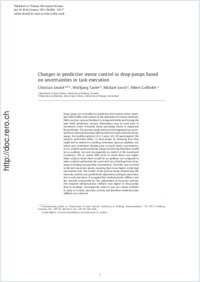Changes in predictive motor control in drop-jumps based on uncertainties in task execution
- Leukel, Christian Department of Sport Science, University of Freiburg, Germany - Department of Medicine, Unit of Sport Science, University of Fribourg, Switzerland
- Taube, Wolfgang Department of Medicine, Unit of Sport Science, University of Fribourg, Switzerland
- Lorch, Michael Department of Sport Science, University of Freiburg, Germany
- Gollhofer, Albert Department of Sport Science, University of Freiburg, Germany
-
14.07.2011
Published in:
- Human Movement Science. - 2012, vol. 31, no. 1, p. 152-160
English
Drop-jumps are controlled by predictive and reactive motor strategies which differ with respect to the utilization of sensory feedback. With reaction, sensory feedback is integrated while performing the task. With prediction, sensory information may be used prior to movement onset. Certainty about upcoming events is important for prediction. The present study aimed at investigating how uncertainties in the task execution affect predictive motor control in drop-jumps. Ten healthy subjects (22 ± 1 years, M ± SD) participated. The subjects performed either (i) drop- jumps by knowing that they might had to switch to a landing movement upon an auditory cue, which was sometimes elicited prior to touch-down (uncertainty). In (ii), subjects performed drop-jumps by knowing that there would be no auditory cue and consequently no switch of the movement (certainty). The m. soleus EMG prior to touch-down was higher when subjects knew there would be no auditory cue compared to when subjects performed the same task but switching from drop-jump to landing was possible (uncertainty). The EMG was reversed in the late concentric phase, meaning that it was higher in the high uncertainty task. The results of the present study showed that the muscular activity was predictively adjusted according to uncertainties in task execution. It is argued that tendomuscular stiffness was the variable responsible for the adjustment of muscular activity. The required tendomuscular stiffness was higher in drop-jumps than in landings. Consequently, when it was not certain whether to jump or to land, muscular activity and therefore tendomuscular stiffness was reduced.
- Faculty
- Faculté des sciences et de médecine
- Department
- Département de Médecine
- Language
-
- English
- Classification
- Sports sciences
- License
- License undefined
- Identifiers
-
- RERO DOC 27222
- DOI 10.1016/j.humov.2011.04.006
- Persistent URL
- https://folia.unifr.ch/unifr/documents/301934
Statistics
Document views: 83
File downloads:
- tau_cpm.pdf: 194
